By John Wukovits
World War II was less than six months old when the American public, already stunned by the debacles at Pearl Harbor and Guam, faced one of its darkest moments. Thousands of miles across the Pacific, the American commander in the Philippines, Maj. Gen. Jonathan Wainwright, surrendered to the Japanese. “With broken heart and head bowed in sadness but not in shame,” he radioed on May 6 to President Franklin D. Roosevelt from his bastion at Corregidor, “I report to your excellency that today I must arrange terms for the surrender of the fortified islands of Manila Bay.”
But the tides of war often turn dramatically. Within 72 hours, American ships, planes, and sheer guts would turn gloom and despair into optimism and hope in a little-known portion of the South Pacific. The naval encounter in the Coral Sea, the lustrous waters bordering Australia’s northeast coast, would knock the Japanese back on their heels and give both the American public and its military cause to celebrate.
The Japanese steamed into the Coral Sea with every reason to believe that another success lay before them. They had triumphed everywhere in the Pacific since December 7, 1941, when they had administered a crushing blow to ill-prepared American naval units at Pearl Harbor. What could possibly halt them now?
Intercepting the Japanese Plans
Three Japanese naval forces converged on the Coral Sea. A left arm under Rear Admiral Kujohide Shima, featuring one minelayer, two destroyers, a transport, and various smaller craft, would seize the small island of Tulagi off Guadalcanal’s northern coast in the Solomon Islands for use as a seaplane base. At the same time, Rear Admiral Sadamichi Kajioka’s right arm of 12 troop transports, escorted by the new light carrier Shoho and four heavy cruisers, would advance south from Rabaul, steam through Jomard Passage in the Louisiades, and seize Port Moresby on the southeast coast of New Guinea. This bold thrust would place Japanese forces within easy range of Australia itself and threaten vital American supply lines to the distant Allied nation.
To the east of the Coral Sea, Vice Admiral Takao Takagi led two carriers, Shokaku and Zuikaku, proud veterans of Pearl Harbor, escorted by two heavy cruisers and six destroyers, to intercept any American naval force trying to halt the Port Moresby invasion. Most Japanese commanders doubted that any American carriers remained in the region. They fully expected to achieve their objectives before the United States could mount an effective answer.
The United States, however, was more aware of the unfolding events than the Japanese realized. Due to the tireless efforts of American code breakers, analysts could read up to 15 percent of the Japanese JN-25 code, their most widely used code. Radio analysis plotted Japanese movements by studying the location, volume, and pattern of intercepted messages, giving Admiral Chester W. Nimitz, commander in chief of the Pacific Fleet, vital information on enemy troop movements.
By early April, the Navy’s intelligence team at Pearl Harbor under Lt. Cmdr. Joseph J. Rochefort was able to provide Nimitz with details of the Japanese plans for the Coral Sea offensive. Rochefort estimated that the Japanese had no intention of invadeing Australia itself, but that they would shortly launch an operation to seize the eastern end of New Guinea. This move would be quickly followed by a vast operation in the Pacific that would involve most of the Combined Fleet.
The news greatly concerned Nimitz, whose capabilities were hampered by the absence of Admiral William Halsey and two carriers, then taking part in the Doolittle air raid of mainland Japan. At a time when he most needed every resource at his disposal, a key component of Nimitz’s air arm was busy on a bombing raid against Tokyo. He had two remaining carriers to deploy, but if he committed them to the Coral Sea, he left an unprotected Pearl Harbor open to further attack.
Nimitz’s intelligence officer, Commander Edward T. Layton, reassured him that no enemy naval forces were steaming toward Hawaii. Nimitz decided to gamble. The enemy may have more powerful forces to commit to battle, but Nimitz knew their plans in advance and thus had the element of surprise on his side. He could place his ships at optimum positions to halt the Japanese advance.
The Race to the Coral Sea
On April 25, Nimitz met in San Francisco with Admiral Ernest King, commander of the U.S. Fleet and chief of naval operations. King and Nimitz both worried that Rear Admiral Frank J. Fletcher, who commanded the two available aircraft carriers, was too timid, but they doubted that the more aggressive Halsey would return from the Doolittle Raid in time to be involved in the coming action. Called “Whiskey Jack,” Fletcher was aboard the carrier Yorktown when his orders arrived. He was to rendezvous with Rear Admiral Aubrey Fitch’s TF-11, anchored by the carrier Lexington, 300 miles south of Tulagi at a position called Point Buttercup. There they were to join four cruisers coming from Australia under Australian Admiral Sir John Crace and halt the Japanese, even though Fletcher commanded a mere half of the firepower his opponent could bring to bear.
As Fletcher churned to the Coral Sea, Halsey returned from his raid. On April 25, he entered Pearl Harbor with Hornet and Enterprise, only to learn that he would soon be on his way to the South Pacific. He was to depart no later than April 30 and race 3,500 miles across the Pacific to the Coral Sea. If Halsey arrived in time to participate in the battle, he would be the senior commander and would take charge of all four carriers, including Fletcher’s Yorktown and Lexington. Halsey was six days away from the Coral Sea.
On May 3, the Japanese occupied Tulagi, and Fletcher hurried north on his own rather than rendezvousing with Fitch or Crace. This bold move divided his forces, leaving him vulnerable to a strong Japanese attack, but luck was on his side as a massive cold front containing rain squalls and winds up to 35 knots hid him from enemy search planes.
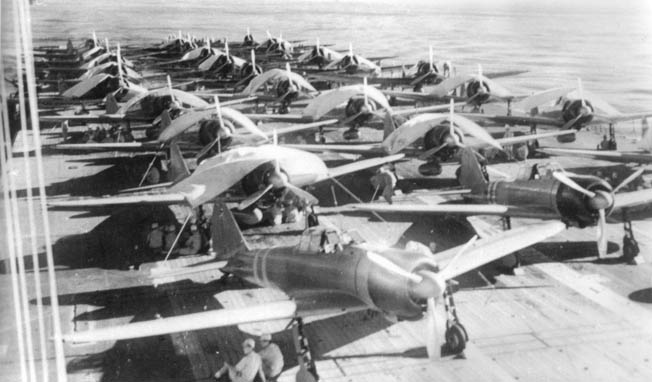
“Some Fun!”
Twelve Devastator torpedo planes and 28 Dauntless dive-bombers lifted off Yorktown shortly after 7 am on May 4, flying without fighter protection, which Fletcher needed to hold back in case the carrier was attacked. An hour later, Lt. Cmdr. William O. Burch led the bombing raid against Tulagi. Most of the Dauntlesses’ bombs fell wide of their marks, in part because their windows and gun sights had fogged over when the planes dropped from cooler temperatures in the upper altitudes to the warmer climes below. The Devastators proved ineffective as well, hitting only one minesweeper with 11 torpedoes. Two subsequent runs produced similarly disappointing results, with most bombs hitting far from their targets.
Fletcher, encouraged by accounts that his aviators had innocently exaggerated, reported to Nimitz that he had sunk two enemy destroyers, three gunboats, and a cargo ship and damaged several others. “Some fun!” he told Nimitz. His commander radioed back: “Congratulations and well done to you and your force. Hope you can exploit your success with augmented force.” Fletcher, in truth, had inflicted only minor damage. The Japanese lost the destroyer Kikuzuki, two light minesweepers, and a merchant minesweeper.
The air attack on Tulagi spurred the Japanese to action as they now knew, much to their consternation, that at least one American carrier was operating in the area. In response, the Japanese sent Admiral Takagi with Shokaku and Zuikaku from Rabaul, escorted by two heavy cruisers, around the eastern end of the Solomons into the Coral Sea. They had one thought in mind—find and destroy the American carriers.
For two days the opposing forces scoured the Coral Sea without success, coming within 70 miles of each other on May 6 without realizing it. One Japanese land-based search plane sighted and correctly reported Fletcher’s position that day, but that resulted in no response when the report was routed through Rabaul instead of directly to Takagi.
Drawing Off the Japanese Attack
Fletcher and Takagi sent search planes out again on the morning of May 7. A Japanese pilot spotted the tanker Neosho and her escort, the destroyer Sims, at 7:36 am, but in his excitement the pilot reported the pair as a carrier and a cruiser. Armed with this misleading information, Takagi launched all planes from both his carriers, and it was not until they arrived over the American vessels that the Japanese realized they had not found the aircraft carriers.
The two American ships below were helpless against the onslaught that followed. Four planes broke off from one wave of Neosho attackers to strafe and bomb the tanker, spitting bullets topside and against the hull. Other aircraft rocked Sims with three bombs. The first landed on the no. 2 torpedo mount and exploded in the forward engine room, the second hit the after upper deck house and exploded in the after engine room, and the third bomb smashed onto the no. 4 gun. Within a minute, Sims split in half and began to sink. As the destroyer disappeared, a sailor in the water saw the captain, Lt. Cmdr. Willford M. Hyman, on the bridge, “riding her down like one of the captains of old.” A huge explosion lifted the ship 10 feet out of the water, leaving only 68 survivors.
At the same time, Neosho absorbed seven hits, including a suicide plane smacking into the no. 4 gun station. The ship’s machine gunners remained at their jobs, firing at the enemy planes even though two men were killed instantly, one being decapitated by flying fragments. Captain John S. Phillips and the crew drifted powerless for four days in the damaged Neosho before a rescue ship, the destroyer Henley, located them on May 11. After removing 123 survivors, Henley sank the oiler with torpedoes. In all, 235 men were lost on Sims and another 179 on Neosho.
This attack cost Takagi only six planes, but the disappointed commander was after larger targets. Instead of hunting down enemy carriers, his air units had been occupied all morning against secondary vessels. Neosho and Sims had unwittingly drawn the attack the Japanese intended for the carriers, leaving Fletcher untouched and free to strike. There was only one problem—he had not yet located the Japanese. It was not for a lack of trying. Fletcher split his force at dawn, sending Crace west to block a Japanese advance through the Louisiades while Fletcher headed north to guard the route.
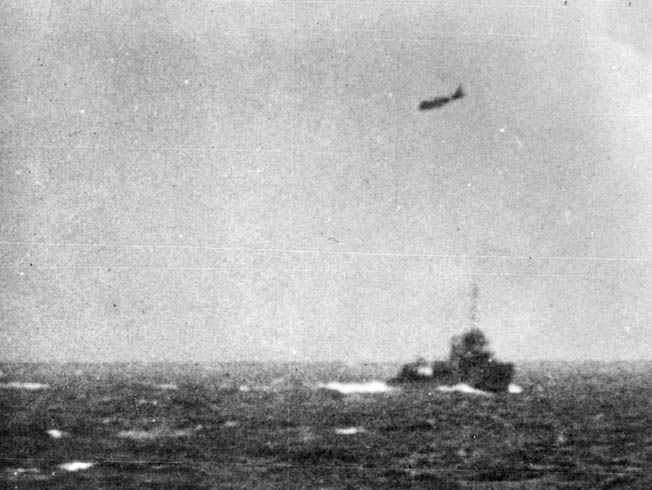
“Dixon to Carrier. Scratch One Flattop!”
Fletcher’s hunt apparently ended at 8:15 when a search plane sent word of two carriers and four heavy cruisers 175 miles northwest of Fletcher. Convinced that he had discovered Takagi’s main force, Fletcher ordered all planes to attack. The force was already on its way when the pilot returned and reported that instead of carriers, he had actually sighted two heavy cruisers and two destroyers. Fletcher erupted at the news, telling the unfortunate pilot that his error had just cost the United States two carriers. Fletcher’s planes were now flying against comparatively minor targets and speeding away at a time when he needed them to defend against Takagi’s carriers, which had to be somewhere close.
The planes sent to hit the supposed two carriers did not return empty-handed, however. As they raced toward what they thought would be Takagi’s main force, American pilots stumbled on Shoho and four heavy cruisers just north of the Jomard Passage in the Louisiades. At 10:50 am, 93 planes attacked, but as it was not yet standard procedure to have a strike coordinator, all the aircraft went after the big game—the carrier—and left the cruisers untouched. An aerial melee ensued as Japanese fighters rose to meet the intruders, following the Americans as they dipped to deliver their attacks. Lt. Cmdr. Robert Dixon of Lexington said the fighters “came right on down with us in a terrible free-for-all mix-up, staying with us right to the water.”
The surprised Shoho still had planes on her deck and elevator. When she turned into the wind to launch, she presented an easy target to American aviators. Bombs struck near the after elevator and exploded inside the rear hangar at 11:20, while five torpedoes crashed into the starboard stern, wrecking the carrier’s steering and propulsion. In less than 30 minutes, Shoho was dead in the water.
The carrier sank after a tremendous explosion, flames leaping 400 feet into the air. More than 600 of the 900-man Japanese crew died, and all but three planes were lost. Shoho was the first Japanese ship larger than a destroyer sunk by Americans in the war. An excited Dixon uttered a memorable phrase that was widely printed by newspapers back home when he radioed back: “Scratch one flattop! Dixon to carrier. Scratch one flattop!”
Numbers Against Battle Experience
The carrier’s loss caused Takagi, who first wanted to destroy the American forces, to order the transports heading toward Port Moresby to remain north of the Louisiades rather than continue through Jomard Passage. The pullback marked the farthest south the Japanese would reach in the war. The steady advance begun on December 7 had been halted. From this point on, the Japanese would be heading in the opposite direction.
That night Takagi dispatched another group of aircraft to locate and hit Fletcher. The planes failed to find their quarry, and as they returned American fighters pounced on them, shooting down nine in the process. Eighteen surviving Japanese planes continued searching for their own carriers in the dark. When they spotted carrier lights, the pilots blinked a request in Morse code to land, but were greeted instead by hostile antiaircraft fire. In the darkness they had flown toward Lexington, which shot down more of the group as the rest fled.
Fletcher considered sending a surface force to engage the Japanese, but without clear knowledge of their location, he did not want to split his force. He needed every ship and aircraft for whatever lay ahead the next day. Fletcher possessed 122 aircraft and five heavy cruisers, one more of each than what Takagi brought to the battle. The Americans had the edge in destroyers and radar, but Takagi’s force was battle tested and experienced, while Fletcher’s was not. Whichever commander found the other first would have the upper hand.
Anticipating a Clash
May 8 was torridly hot. Expecting battle, medical teams aboard the American carriers and escort vessels prepared surgical dressings and morphine. Yorktown’s canteen issued 10,000 candy bars so that the sailors would have something to eat while at their battle stations. Miles distant, the Japanese handed out rice cakes to their crews. It looked to be a long day for both sides.
Eighteen scouting planes lifted off from Lexington at 5 am. The ship’s captain, Frederick C. Sherman, concluded that the skies would be filled with aircraft from both sides trying to locate the other. Chances were that the opponents would see each other at the same time, creating a situation in which the two foes might deliver their knockout blows at the same time. “There we were,” wrote news correspondent Stanley Johnston, aboard Lexington, “two powerful air-striking forces within 30 miles of one another wrapped in the invisibility lent by a rainy night. All of us felt that morning would bring a momentous day. In our enemy we recognized a tough, fanatical foe whose courage and cunning could not be discounted. Our forces appeared about equal. It seemed to be a question of who would get the first blow home. All of us felt that history was in the making.”
The situation called for risks, and at 7:15 the Japanese air commander gambled and launched 69 torpedo planes and dive-bombers before his scouts had found Fletcher. He believed the search planes would soon locate the American carriers and provide his attackers with the necessary information. He surmised correctly. At 8:02 am, Yorktown’s radar picked up an aircraft 18 miles to the northwest and heard the pilot radio his report. Sherman predicted that the Japanese air group would appear at about 11 o’clock. He could only hope that his search planes could locate the enemy soon. His wishes materialized at 8:20, when an American scout plane piloted by Lt. J.G. Smith spotted Shokaku and Zuikaku 175 miles northeast of the Lexington and heading south.
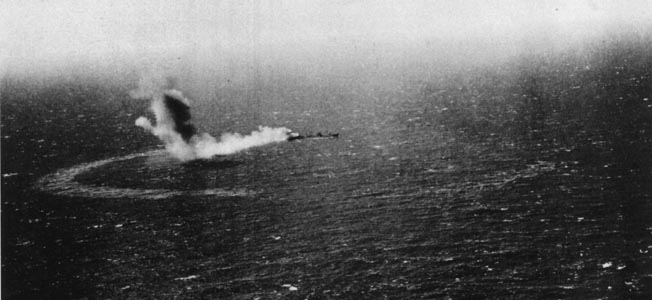
At 8:22, Sherman, aboard Lexington, received Smith’s contact report. Two minutes later he intercepted a radio transmission from a Japanese aircraft indicating that the enemy had also spotted the Americans. The first carrier duel of the war was about to begin.
Taking Shokaku Out of Action
In the ready rooms of both Yorktown and Lexington, pilots leapt to their feet. Thirty Dauntlesses, nine Devastators, and 14 Wildcats lifted off Yorktown, followed 10 minutes later by Lexington’s 24 Dauntlesses, 12 Devastators, and 10 Wildcats. By 9:25 the air groups from both American carriers had departed. Ninety-five minutes later the Yorktown bombers sighted the two enemy carriers eight miles apart. Instead of attacking immediately, the bombers circled for 20 minutes, waiting for the slower torpedo planes to arrive. This unfortunate lapse gave the Japanese time to launch additional fighters, while Zuikaku raced toward a nearby rain squall for shelter.
Lieutenant Joseph Taylor of Yorktown started the fight by leading a group of torpedo planes toward Shokaku. As Zeros pounced on the inexperienced Americans, dive-bombers followed from 17,000 feet and dropped two 1,000-pound bombs on Shokaku, mangling the flight deck and destroying the aircraft repair shop.
Lieutenant John J. Powers held steady as his plane sped toward Shokaku, waiting until beyond the normal release point to ensure his bomb hit the target. Powers successfully landed a direct hit, but the explosion demolished him and his plane. Most of the other American aircraft missed with their bombs or torpedoes. One Japanese sailor joked that the American torpedoes were so slow that “we could turn and run away from them.” Not one of the Mark 13 torpedoes found its target.
The American pilots lost 43 aircraft while registering only a handful of hits. However, these successes ignited gasoline fires aboard Shokaku. Although the Japanese brought the fires under control, the carrier was no longer able to launch aircraft from her warped deck. Losing her main capability, the carrier limped back to Truk, where extensive repairs kept her out of action until July.
“They’re Going to Bop Us”
It now became Fletcher’s turn as Japanese forces descended on both American carriers. As Lt. Cmdr. Kuichi Takahashi searched the Coral Sea with 69 aircraft, the pilot who had first discovered Fletcher, Warrant Officer Kanzo Kanno, flew directly across Takahashi’s path and agreed to lead the planes to the carriers. Kanno did this knowing that he would not have enough fuel to make it back to his own carrier.
At 10:55, Yorktown’s radar detected the Japanese force 68 miles out. Each carrier launched eight Wildcat fighters, but the fighters flew at an altitude far below that of the oncoming Japanese formation, an error that allowed the enemy planes to safely fly above the American fighters. Stripped of his aerial defenses, Fletcher, who stood outside Yorktown’s flag bridge wearing an old-style World War I helmet and watching through binoculars, would have to rely on his antiaircraft guns to ward off the enemy. Yeoman Tom Newsome, standing just inside the door, heard Fletcher say, “They’re going to bop us.”
Takahashi led his planes in at 11:18, coming out of the sun at a 45-degree angle. A wall of American antiaircraft fire greeted the intruders, hitting one of the first invaders so accurately that the plane disintegrated, sending the crew spinning into the skies. Yorktown evaded the first string of torpedoes with a series of desperate maneuvers, but the ship could not escape every missile sent against her. At 11:25, 14 Japanese dive-bombers straddled the carrier with 11 near misses that loosened hull plating, rained shrapnel against gun mounts and bridge, and lifted the ship’s screws completely out of the water.
Crewmen on Yorktown could easily see the bombs drop from aircraft that dipped to 1,500 feet above the water’s surface before releasing their bombs. Captain Elliott Buckmaster engaged in evasive actions with each of the attacking aircraft, waiting until the pilot committed to his dive and then swinging the rudder sharply toward the plane to present smallest target. When one Japanese pilot pulled out low over the water, Buckmaster had already begun to engage the next bomber, issuing such a constant stream of course changes that the carrier made a series of giant “S” imprints on the surface.
Dozens of near misses straddled the carrier, and six bombs showered the ship with shrapnel. One bomb struck the carrier flight deck and exploded inside, killing or wounding 66 crewmen. Another bomb penetrated Yorktown’s flight and hangar decks before exploding four levels below, killing 37 men. Although mortally wounded from the blast, Lieutenant Milton E. Ricketts, commander of Repair Party 5, opened a fireplug valve, aimed the hose at the center of the fire, then crumpled to the deck and died. Crews managed to extinguish the flames before too much damage was done, enabling the carrier to continue at 24 knots.
“The Air Fighting Now Became a Melee”
Lexington faced her own ordeal. At 11:13 am, the port side 5-inch guns on the carrier opened fire. According to pilot Ensign Ralph V. Wilhelm, the “sky was just a solid blanket of antiaircraft bursts all between 1,000 and 3,000 feet altitude.” Thirteen torpedo planes attacked Lexington in an arc that extended from the port beam and across both bows in an anvil formation, approaching the carrier on both sides of her bow so that no matter which direction Captain Sherman directed the ponderous carrier, she would turn toward a bevy of torpedoes.
“The air fighting now became a melee,” wrote Sherman. “Our own planes were mixed in with the enemy and the sky was black with flak bursts.” Despite the intense antiaircraft fire, the Japanese charged straight at the carrier rather than drop out of formation, a courage that impressed Sherman. “It was beautifully coordinated. From my bridge I saw bombers roaring down in steep dives from many points in the sky, and torpedo planes coming in on both bows almost simultaneously. There was nothing I could do about the bombers, but I could do something to avoid the torpedoes.”
One bomb appeared to be falling right at the admiral, who briefly wondered if he should duck behind the thin armored shield. He concluded that if he were meant to die from that bomb, there was nothing he could do about it, so he turned his attention to evading the torpedoes by turning the massive carrier slowly to one side or the other.
Torpedo wakes dissected the ocean, while bombs splashed on both sides. “Great geysers of water from near misses were going up higher than our masts,” recalled Sherman, “and occasionally the ship shuddered from the explosions of the ones that hit.” He evaded the first torpedoes and shifted rudder to outmaneuver the second group of planes, but when they split to attack both bows, “it became a matter of wriggling and twisting as best we could to avoid the deadly weapons heading our way.”
Two wakes that Sherman knew he could not avoid churned directly toward the port beam, and he braced himself for the explosion. Nothing happened. The torpedoes were running too deep and had passed completely under the ship. Two more torpedoes ran parallel to the ship 50 yards out on either side and passed close by, but Sherman’s luck had run out. At 11:18, a torpedo struck Lexington’s port side near the island, two minutes before two more slammed into the port side near the bow. In quick succession a 1,000-pound bomb smashed into the flight deck and a 500-pound bomb demolished the smokestack.
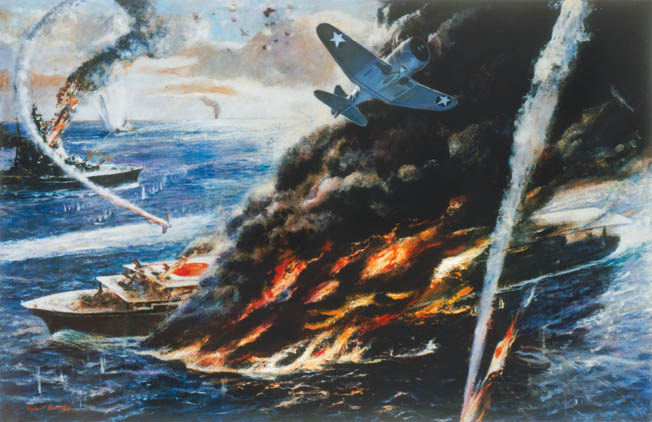
Sinking the Lexington
The brief battle packed incredible death and destruction in its few minutes. By 11:40, the fighting had ended, only 22 minutes after the first torpedo splashed into the ocean. “Suddenly all was quiet again,” wrote Sherman. “It was as though some hidden director had signaled for silence. The Japanese planes were no longer in sight, the guns had stopped shooting for lack of targets.” He glanced at his watch and noticed that the attack had lasted only nine minutes. “It seemed hours since we had first sighted the enemy planes.”
While both American carriers sustained damage, they were able to maintain speeds of 25 knots and resume flight operations. Sherman, who had wondered if his ship would emerge from the fight, was delighted with the results. Lexington was far from secure, however. Aboard the ship, correspondent Stanley Johnston was writing about the day’s action for newspaper readers back home when at 12:47 pm a huge internal explosion rattled the ship. “I was sitting in the navigating cabin, writing up the events of the morning from my notes when there came a jolt heavier than any of the explosions during the battle,” recalled Johnston. “Then from deep down inside the ship resounded the dull rumble of an explosion.” The eruptions rocked the carrier as smoke emerged from the edges of the flight deck elevator.
Caused by an accumulation of gasoline vapors leaking from damaged storage tanks, the fires quickly spread, turning the surface of the elevator in the flight deck to an ominous dull red. The bulkhead in the forward engine room was white-hot, and temperatures soared to 160 degrees, causing dizziness and violent headaches among the fire tenders. Fires rapidly spread in the ship’s lower levels, causing additional explosions that made damage control all but impossible. The carrier’s executive officer, Commander Morton T. Seligman, realized that the ship was doomed. Sooner or later the flames would reach the torpedo warheads on the mezzanine of the hangar deck and cause more severe explosions. One officer put his hand to a torpedo warhead to test it and immediately jerked it away in pain. He looked down to see his hand covered with blisters.
At 5:07 pm, Admiral Fitch said to Sherman, “Well, Ted, let’s get the men off.” Although hesitant to give up his ship, Sherman saw no other course and agreed with Fitch. He reluctantly gave the order to abandon ship. While the wounded were lowered to waiting boats, the rest of the crew slid down ropes into the 80-degree water, where they were quickly retrieved by escorting destroyers. The crew abandoned the ship with such calm that not one life was lost. Some of the crew filled their helmets with ice cream from the service store and calmly ate it while they waited. Others neatly aligned their shoes on deck. “There was not the slightest panic or disorder. I was proud of them,” wrote Sherman.
Sherman ordered Seligman to leave, then stood alone on the carrier for a final glimpse. While he struggled with his thoughts, an immense explosion rocked the carrier amidships by the elevator. Planes and debris flew everywhere, forcing Sherman to duck under the edge of the flight deck for cover. The commander decided that it was time to leave. He walked to the side and slid down the rope into the water.
Fletcher ordered the destroyer Phelps to sink Lexington with torpedoes. At 10 pm, a brace of torpedoes sped toward Lexington while rescued crewmen aboard other ships cried openly. As they watched, the ship that had been their home at sea slowly settled beneath the waves. “The stricken vessel started getting deeper in the water, slowly going down, as if she too was reluctant to give up the battle,” recalled Sherman. “With her colors proudly flying and the last signal flags, reading ‘I am abandoning ship,’ still waving at the yardarm, she went under on an even keel, like the lady she always was. As she disappeared from sight, there was a tremendous underwater explosion from her magazines. It was the end of the Lexington.”
“The Turning Point in the War”
With Lexington’s loss, the Japanese had gained a tactical victory, but the United States had triumphed strategically. For the first time in the war, a Japanese invasion had been rebuffed; the troop-packed transports were ordered back to Rabaul. Repair parties patched Yorktown in time for her to play a key role in the crucial Battle of Midway the following month, while the Japanese sorely missed the presence of the two carriers that saw action in the Coral Sea, a factor that helped tip the scales in America’s favor.
The Battle of the Coral Sea caused celebrations back home. “Japanese Repulsed in Great Pacific Battle with 17 to 22 of Their Ships Sunk or Crippled,” boasted the May 9 issue of the New York Times. Morale that had been shattered by the devastating attack against Pearl Harbor and the swift losses of Wake Island, Guam, and the Philippines now had been lifted. “It was, in truth, the greatest battle in the history of the U.S. Pacific Fleet,” gushed Time magazine. “That day on the sun-bathed Coral Sea the Jap caught hell and absorbed a shattering defeat.” The article added that the Japanese “had unquestionably taken a beating—the first serious defeat of his headlong career through the South Pacific.”
Sherman agreed with Time’s assessment. “The Battle of the Coral Sea was the turning point in the war and a milestone in history,” he wrote. “It proved the dominance of the aircraft carrier and ended the period of Japanese advance.” He likened the battle to the Civil War confrontation between the Monitor and the Merrimack.
Such confusion existed on both sides during the battle that naval historian Samuel Eliot Morison labeled Coral Sea the “Battle of Naval Errors.” But the esteemed chronicler also recognized the positive impact the battle had made to the American cause. “Call Coral Sea what you will,” wrote Morison, “it was an indispensable preliminary to the great victory of Midway.” That in itself made the Battle of the Coral Sea a signal chapter in American military history.
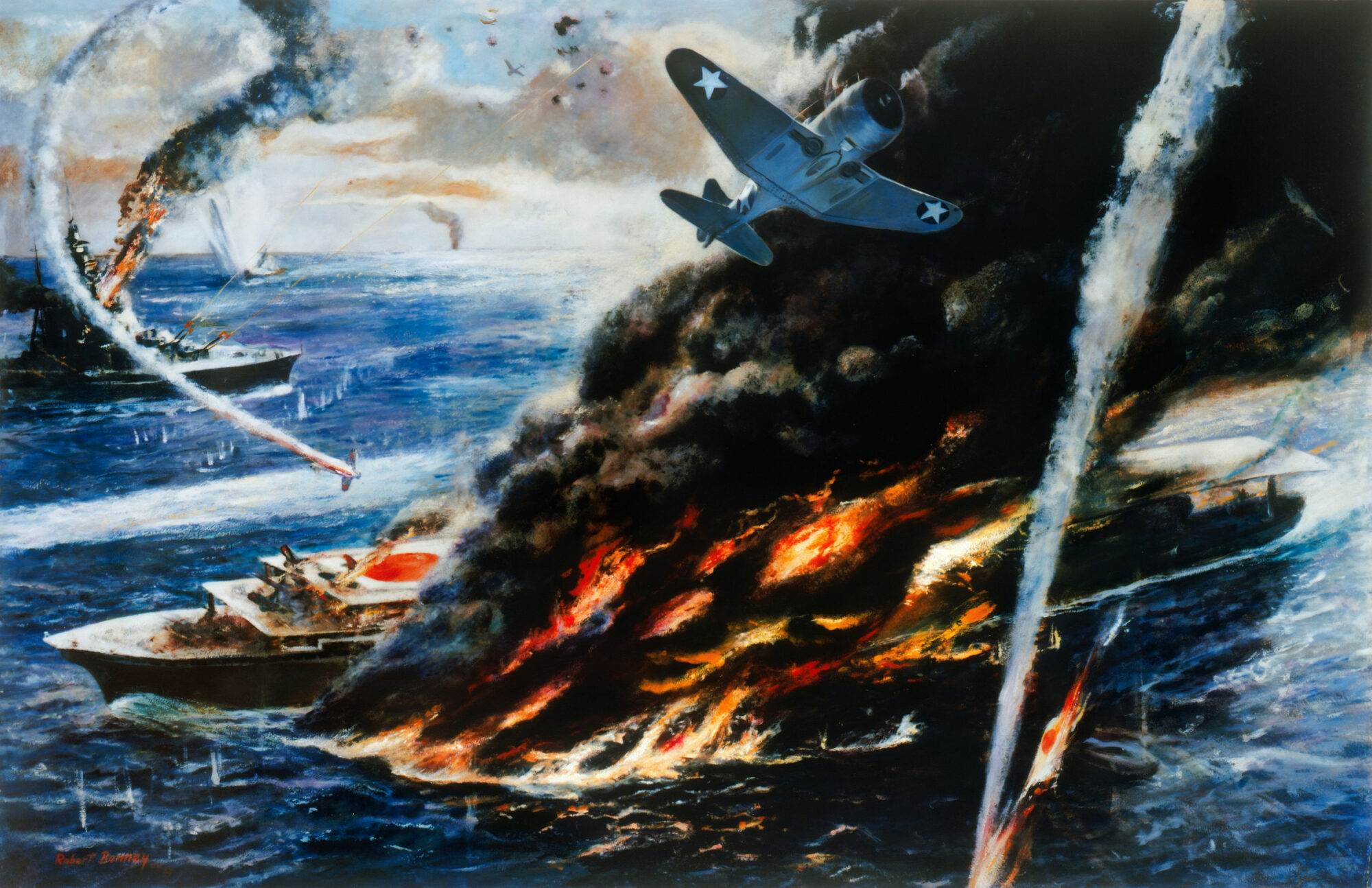
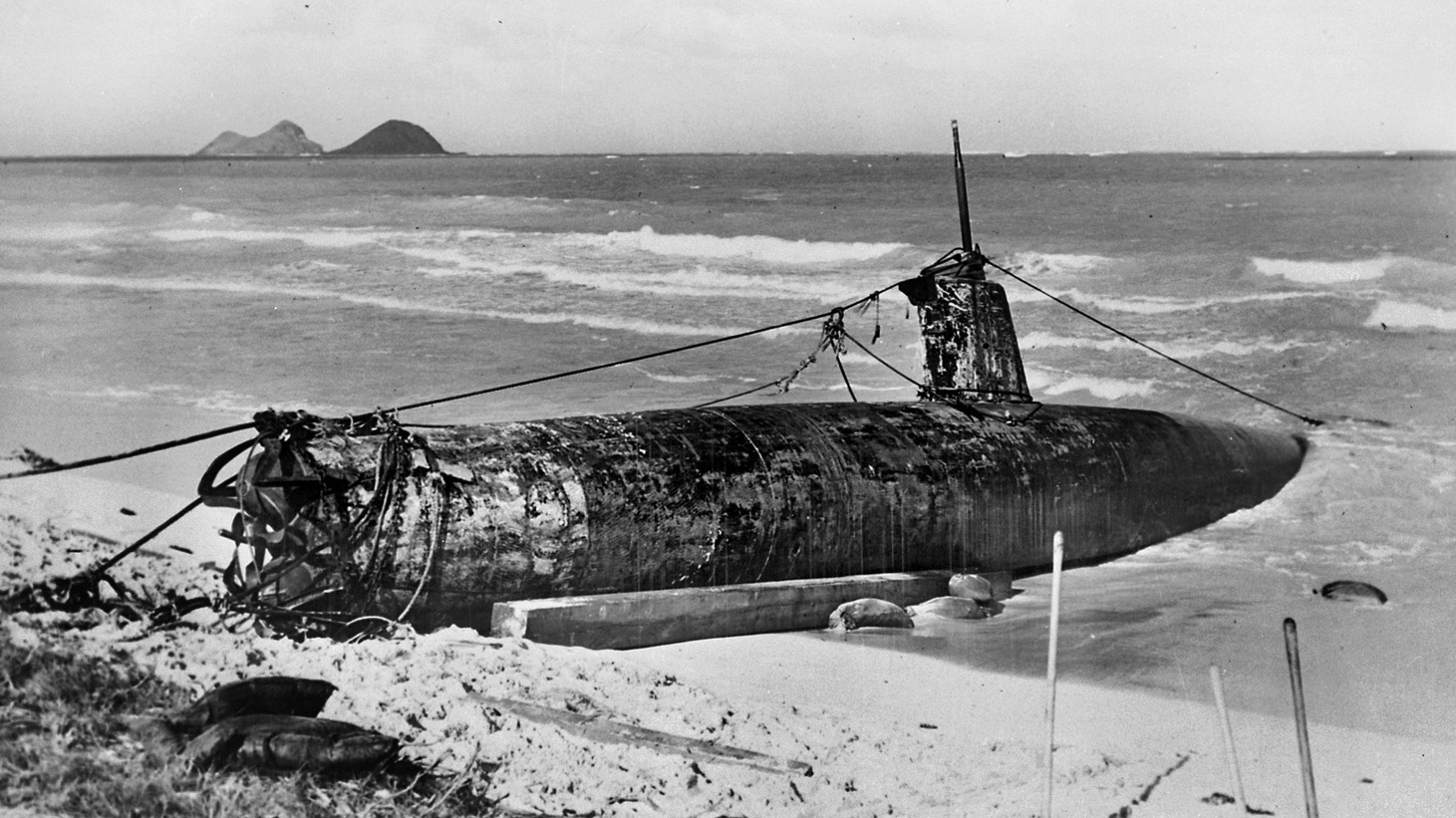
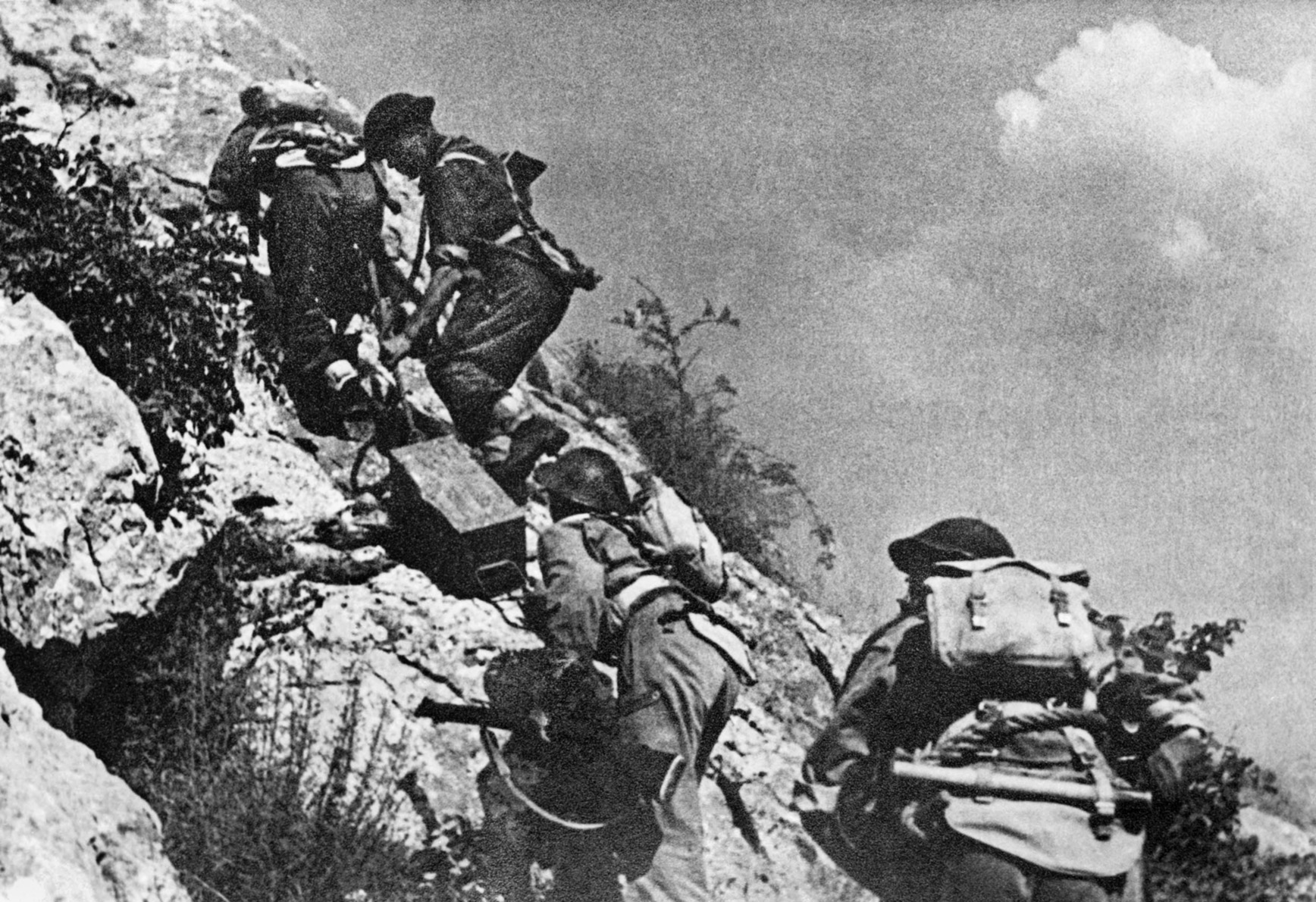
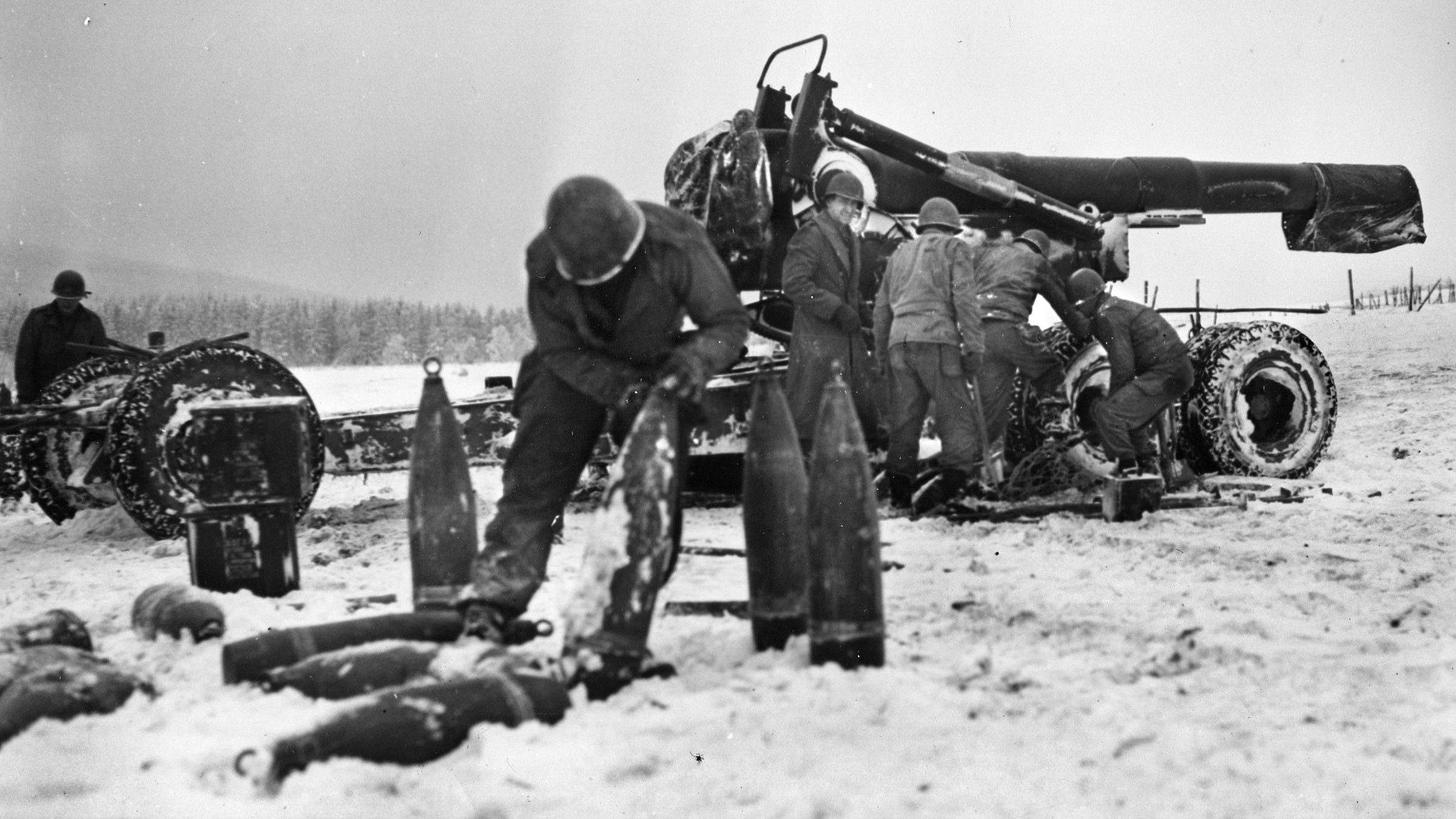
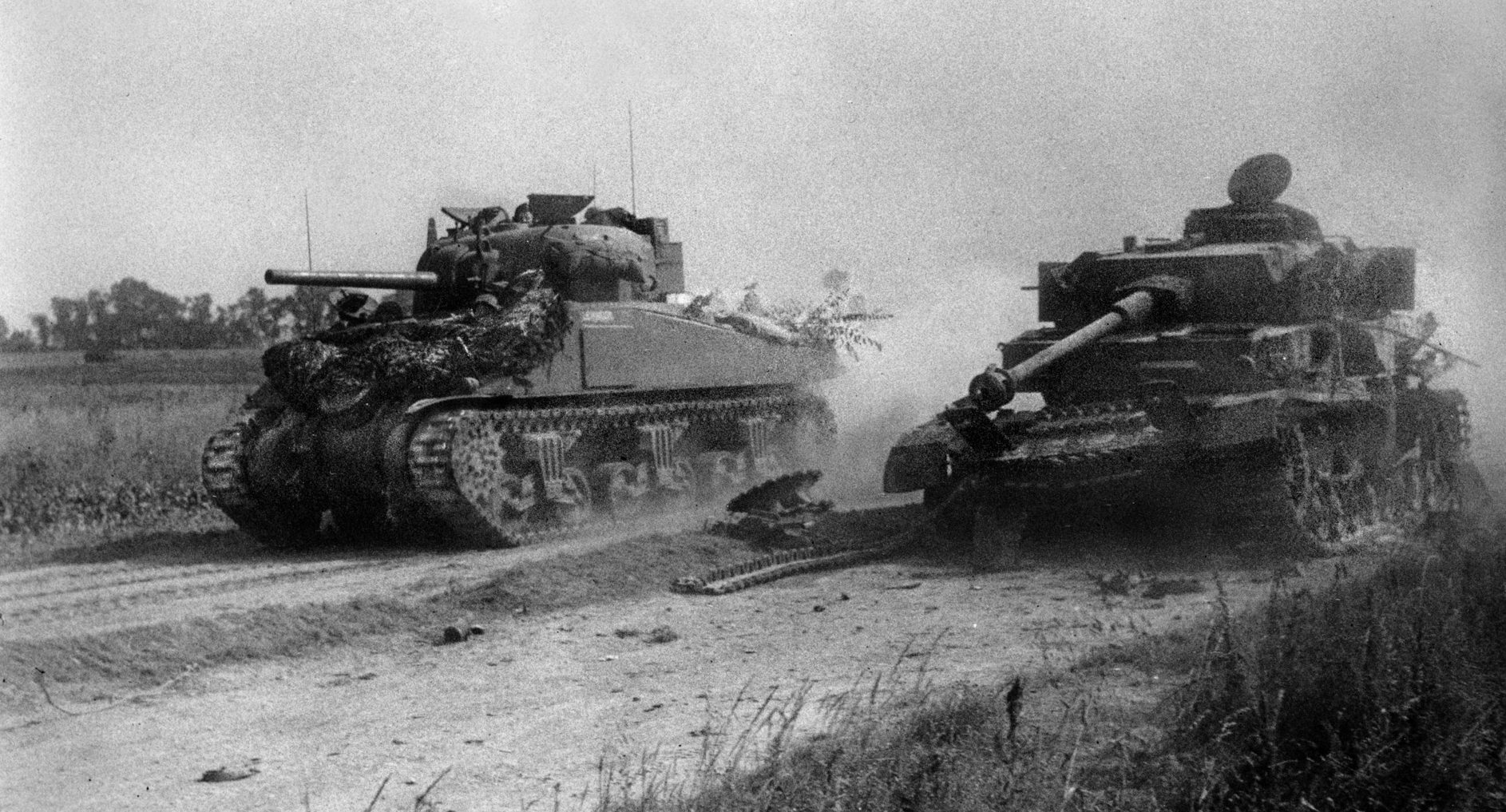
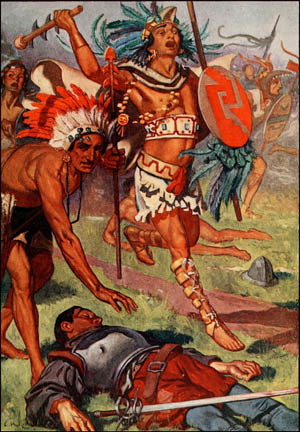
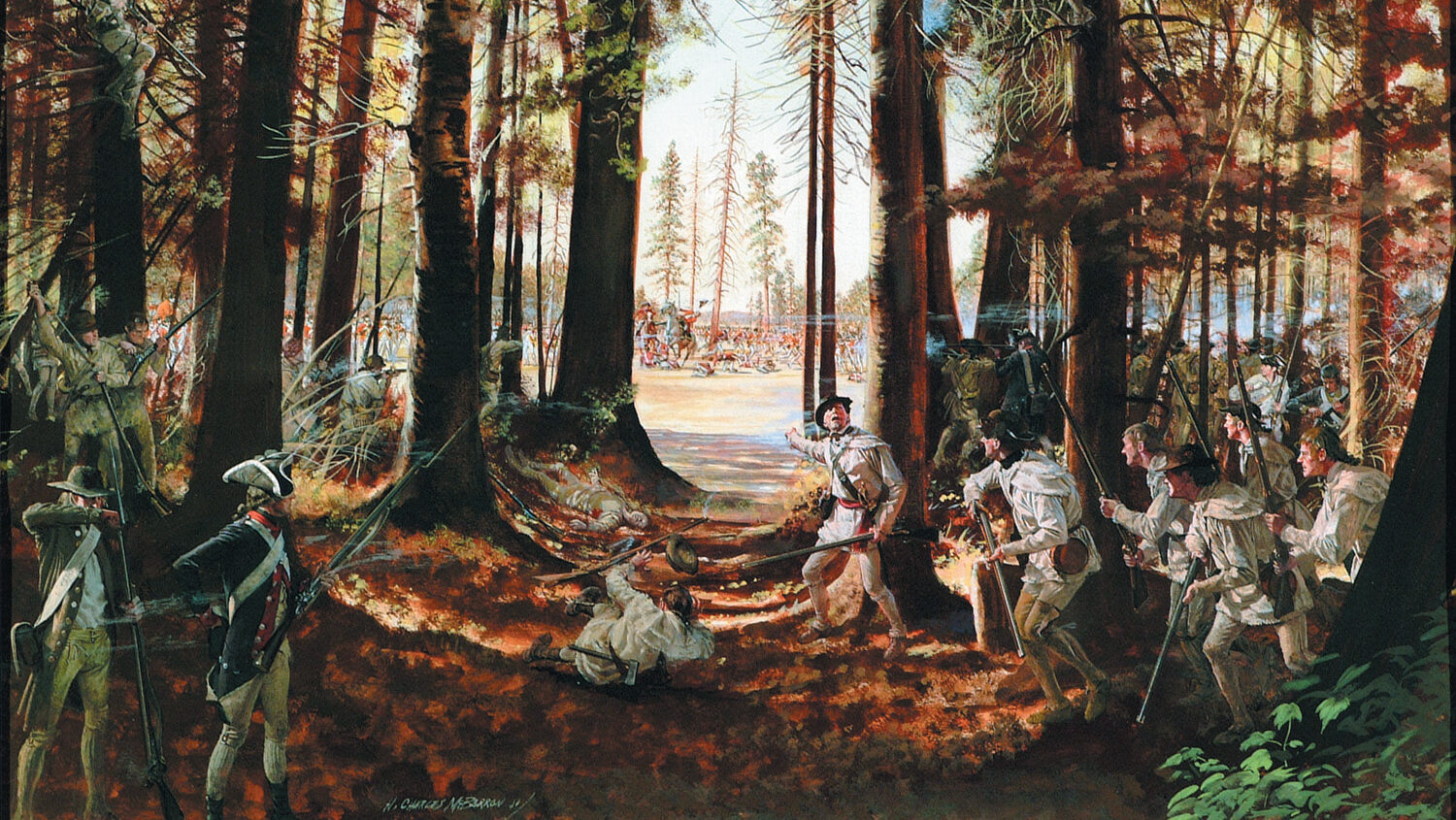
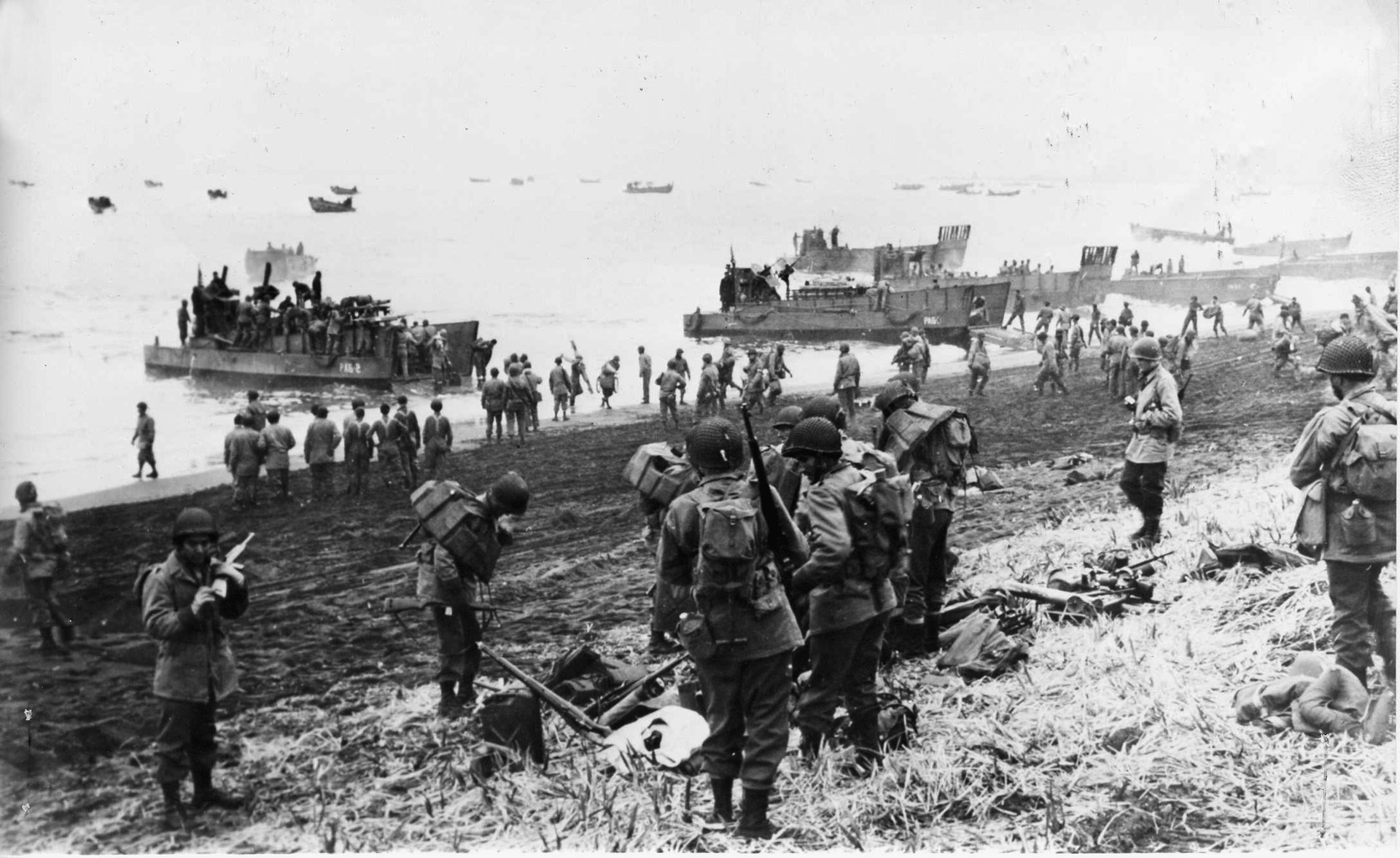
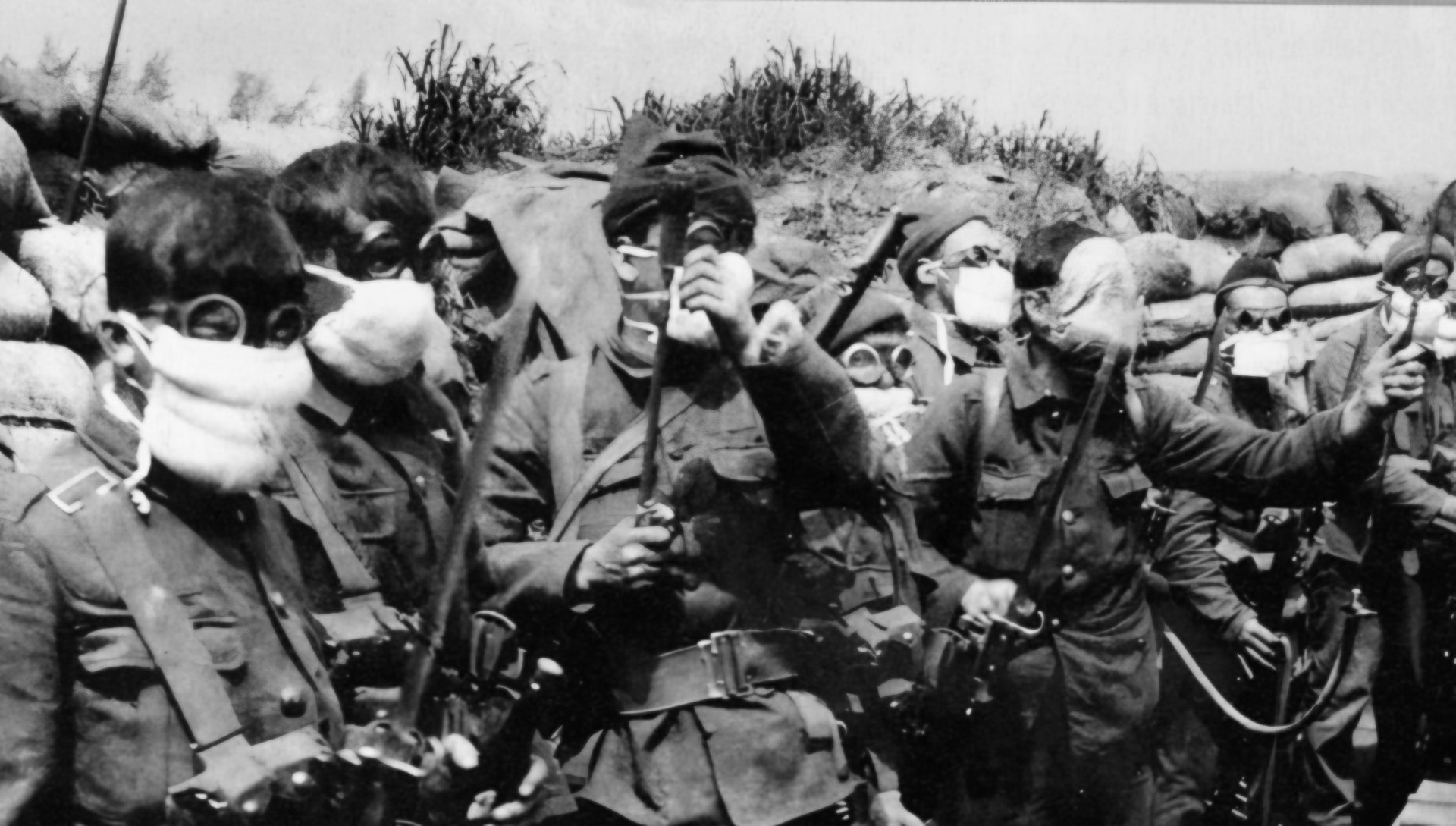
Joseph Taylor is my grandfather. I am working to get him the medal of honor.
Despite the publicity that Midway received in the form of a couple of Hollywood films, Coral Sea was invaluable to the allies in the Pacific as it halted the Japanese advance toward Australia. This, in turn, convinced Yamamoto to plan for Midway to remove American naval presence in the area. The result was a defeat for the Japanese that set the agenda in America’s favor for the next three years until final victory.